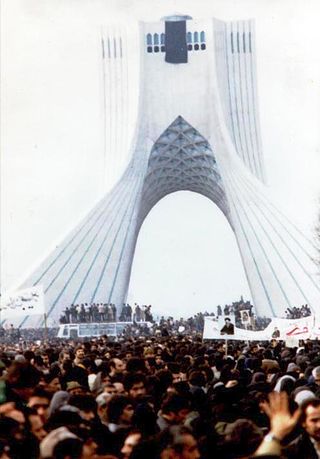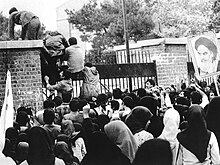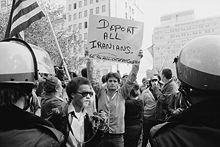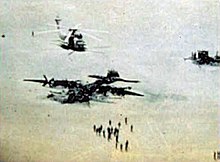
The Iranian Revolution, also known as the Islamic Revolution, was a series of events that culminated in the overthrow of the Pahlavi dynasty in 1979. The revolution also led to the replacement of the Imperial State of Iran by the present-day Islamic Republic of Iran, as the monarchical government of Mohammad Reza Pahlavi was superseded by the theocratic government of Ayatollah Ruhollah Khomeini, a religious cleric who had headed one of the rebel factions. The ousting of Pahlavi, the last Shah of Iran, formally marked the end of Iran's historical monarchy.

Mohammad-Ali Rajai was the second president of Iran from 2 August 1981 until his death. He served also as prime minister under Abolhassan Banisadr. In addition, Rajai was minister of foreign affairs from 11 March 1981 to 15 August 1981, while he was prime minister. He was assassinated in a bombing on 30 August 1981 along with prime minister Mohammad-Javad Bahonar.

Seyyed Abolhassan Banisadr was an Iranian politician, writer, and political dissident. He was the first president of Iran after the 1979 Iranian Revolution abolished the monarchy, serving from February 1980 until his impeachment by parliament in June 1981. Prior to his presidency, he was the minister of foreign affairs in the interim government. He had resided for many years in France where he co-founded the National Council of Resistance of Iran.

Mohammad-Javad Bahonar was a Shia Iranian theologian and politician who served as the Prime Minister of Iran for less than one month in August 1981. Bahonar and other members of Mohammad-Ali Rajai's government were assassinated by Mujahideen-e Khalq.

The prime minister of Iran was a political post that had existed in Iran (Persia) during much of the 20th century. It began in 1906 during the Qajar dynasty and into the start of the Pahlavi dynasty in 1923 and into the 1979 Iranian Revolution before being abolished in 1989.

Ayatollah Mohammad Reza Mahdavi Kani was an Iranian Shia cleric, writer and conservative and principlist politician who was Acting Prime Minister of Iran from 2 September until 29 October 1981. Before that, he was Minister of Interior in the cabinets of Mohammad-Ali Rajai and Mohammad-Javad Bahonar. He was the leader of Combatant Clergy Association and Chairman of the Assembly of Experts and also founder and president of Imam Sadiq University.

Sayyid Mohammad Kazem Shariatmadari, also spelled Shariat-Madari, was an Iranian Grand Ayatollah. He favoured the traditional Shiite practice of keeping clerics away from governmental positions and was a critic of Supreme Leader Ruhollah Khomeini, denouncing the taking hostage of diplomats at the US embassy in Tehran.

The demonstrations of June 5 and 6, also called the events of June 1963 or the 15 Khordad uprising, were protests in Iran against the arrest of Ayatollah Ruhollah Khomeini after his denouncement of Iranian Shah Mohammad Reza Pahlavi and Israel. The Shah's regime was taken by surprise by the massive public demonstrations of support, and although these were crushed within days by the police and military, the events established the importance and power of (Shia) religious opposition to the Shah, and Khomeini as a major political and religious leader. Fifteen years later, Khomeini was to lead the Iranian Revolution which overthrew the Shah and the Pahlavi dynasty and established the Islamic Republic of Iran.

Cultural Foundation of Refah was an elementary school for girls in Tehran, Iran. It gained historical significance in the 1979 Iranian Revolution when it was the temporary headquarters of the revolutionists led by Ruhollah Khomeini. It was also used for the Islamic Revolutionary Court and the execution of officials of the second Pahlavi Regime on its rooftop before being transformed into what is being currently used as, a cultural and educational institution.

The Council of the Islamic Revolution was a group formed by Ayatollah Ruhollah Khomeini to manage the Iranian Revolution on 10 January 1979, shortly before he returned to Iran. "Over the next few months there issued from the council hundreds of rulings and laws, dealing with everything from bank nationalization to nurses' salaries." Its existence was kept a secret during the early, less secure time of the revolution, and its members and the exact nature of what the council did remained undisclosed to the public until early 1980. Some of the council's members like Motahhari, Taleqani, Bahonar, Beheshti, Qarani died during Iran–Iraq War or were assassinated by the MKO during the consolidation of the Iranian Revolution. Most of those who remained were put aside by the regime.

The mausoleum of Reza Shah, located in Ray south of Tehran, was the burial ground of Reza Shah Pahlavi (1878–1944), the penultimate Shahanshah (Emperor) of Iran. It was built close to Shah-Abdol-Azim shrine.

Many organizations, parties and guerrilla groups were involved in the Iranian Revolution. Some were part of Ayatollah Khomeini's network and supported the theocratic Islamic Republic movement, while others did not and were suppressed when Khomeini took power. Some groups were created after the fall of the Pahlavi dynasty and still survive; others helped overthrow the Shah but no longer exist.

Casualties of the Iranian Revolution refers to those who lost their lives during the Iranian Revolution. Observers differ on how many people died during the Iranian Revolution. The Islamic government uses the figure of 60,000 killed; in reference to this figure, the military historian Spencer C. Tucker notes that "Khomeini's regime grossly overstated the revolution's death toll for propaganda purposes". The sociologist Charles Kurzman, drawing on later more detailed records from the Islamic Republic, believes the number was closer to 2,000-3,000.
Following the Iranian Revolution, which overthrew the Shah of Iran, in February 1979, Iran was in a "revolutionary crisis mode" from this time until 1982 or 1983 when forces loyal to the revolution's leader, Ayatollah Ruhollah Khomeini, consolidated power. During this period, Iran's economy and the apparatus of government collapsed; its military and security forces were in disarray.

The Interim Government of Iran was the first government established in Iran after the Iranian Revolution. The regime was headed by Mehdi Bazargan, one of the members of the Freedom Movement of Iran, and formed on the order of Ayatollah Khomeini on 4 February 1979. From 4 to 11 February, Bazargan and Shapour Bakhtiar, the Shah's last Prime Minister, both claimed to be the legitimate prime minister; Bakhtiar fled on 11 February. Mehdi Bazargan was the prime minister of the interim government and introduced a seven-member cabinet on 14 February 1979. Ebrahim Yazdi was elected as the Foreign Minister.

Sadeq Tabatabaei was an Iranian writer, journalist, TV host, university professor at the University of Tehran and politician who served as Deputy Prime Minister from 1979 to 1980. He was also Deputy Minister of the Interior and oversaw the referendum on establishing an Islamic Republic in March 1979. He was Iran's Ambassador to West Germany from 1982 until 1986.

Ruhollah Khomeini’s return to Iran on 1 February 1979, after 14 years in exile, was an important event in the Iranian Revolution. It led to the collapse of the provisional government of Shapour Bakhtiar and the final overthrow of the Shah of Iran, Mohammad Reza Pahlavi, on 11 February 1979.

Feyziyya School is an old school in Qom, Iran that was founded in the Safavid era. The school has been listed as one of Iran's national monuments as of January 29, 2008. The school is famous in part as the focal point for clerical opposition to Mohammad Reza Shah Pahlavi's White Revolution, and the site of a Ashura 1963 speech by Ayatollah Ruhollah Khomeini denouncing the Shah, after which he was arrested.

This is a timeline of the Iran hostage crisis (1979–1981), starting from the Shah Mohammed Reza Pahlavi's leaving of Iran and return of all hostages to the United States.

Ruhollah Khomeini's life in exile was the period that Grand Ayatollah Ruhollah Khomeini spent from 1964 to 1979 in Turkey, Iraq and France, after Mohamed Reza Shah Pahlavi had arrested him twice for dissent from his “White Revolution” announced in 1963. Ayatollah Khomeini was invited back to Iran by the government, and returned to Tehran from exile in 1979.


























